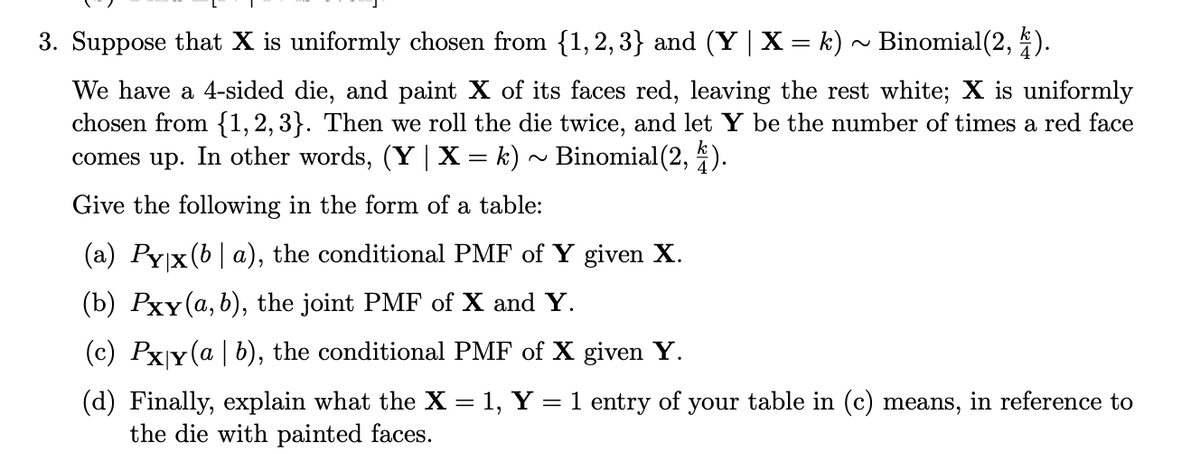Suppose that X is uniformly chosen from {1,2,3} and (Y | X = k) ~ Binomial(2, §). We have a 4-sided die, and paint X of its faces red, leaving the rest white; X is uniformly chosen from {1, 2, 3}. Then we roll the die twice, and let Y be the number of times a red face comes up. In other words, (Y | X = k) ~ Binomial(2, §). Give the following in the form of a table: (a) Pyx (ba), the conditional PMF of Y given X. (b) Pxy (a, b), the joint PMF of X and Y. (c) Pxy (a | b), the conditional PMF of X given Y. (d) Finally, explain what the X = 1, Y = 1 entry of your table in (c) means, in reference to the die with painted faces.
Suppose that X is uniformly chosen from {1,2,3} and (Y | X = k) ~ Binomial(2, §). We have a 4-sided die, and paint X of its faces red, leaving the rest white; X is uniformly chosen from {1, 2, 3}. Then we roll the die twice, and let Y be the number of times a red face comes up. In other words, (Y | X = k) ~ Binomial(2, §). Give the following in the form of a table: (a) Pyx (ba), the conditional PMF of Y given X. (b) Pxy (a, b), the joint PMF of X and Y. (c) Pxy (a | b), the conditional PMF of X given Y. (d) Finally, explain what the X = 1, Y = 1 entry of your table in (c) means, in reference to the die with painted faces.
Algebra & Trigonometry with Analytic Geometry
13th Edition
ISBN:9781133382119
Author:Swokowski
Publisher:Swokowski
Chapter10: Sequences, Series, And Probability
Section10.8: Probability
Problem 32E
Related questions
Question
Need c) and d)

Transcribed Image Text:3. Suppose that X is uniformly chosen from {1,2,3} and (Y | X = k) ~ Binomial(2, 4).
We have a 4-sided die, and paint X of its faces red, leaving the rest white; X is uniformly
chosen from {1, 2, 3}. Then we roll the die twice, and let Y be the number of times a red face
comes up. In other words, (Y | X = k) ~ Binomial(2, 4).
Give the following in the form of a table:
(a) Pyx(ba), the conditional PMF of Y given X.
(b) Pxy (a, b), the joint PMF of X and Y.
(c) Pxy (a | b), the conditional PMF of X given Y.
(d) Finally, explain what the X = 1, Y = 1 entry of your table in (c) means, in reference to
the die with painted faces.
Expert Solution
This question has been solved!
Explore an expertly crafted, step-by-step solution for a thorough understanding of key concepts.
Step by step
Solved in 4 steps with 8 images

Recommended textbooks for you

Algebra & Trigonometry with Analytic Geometry
Algebra
ISBN:
9781133382119
Author:
Swokowski
Publisher:
Cengage

Algebra & Trigonometry with Analytic Geometry
Algebra
ISBN:
9781133382119
Author:
Swokowski
Publisher:
Cengage